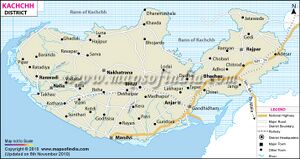Shikarpur Gujarat
| Author:Laxman Burdak, IFS (Retd.) |

Shikarpur (शिकारपुर) is a village in Bhachau Taluka of Kutch district of Gujarat, India. Nearby excavations have revealed a site belonging to the Indus Valley Civilisation, also known as "Harappan Civilisation".
Location
Valmio Timpo, in Bhachau Taluka of Kutch district of Gujarat, India.
Site of Indus Valley Civilisation
The archaeological site is 4.5 kms south of Shikarpur, at Valmio Timpo. It consists of a Harappan settlement covering 3.4 hectares, where the main activity appears to have been the manufacture of artefacts.
Gujarat State Archaeology Department conducted excavations during 1987-1989. These revealed a deposit over 3 metres thick, with its lower layers representing the Early Harappan period and the upper layers representing Mature Harappan.[1] Further extensive excavations were carried in 2007-2008 by The Maharaja Sayyajirao University, Baroda. These discovered some important artefacts and other details.
Artifacts: Among the artefacts found are ornaments of semi-precious stones, steatite and terracotta, bangles made of shell and terracotta, copper chisels and knives, arrowheads, rings, terracotta toy cart frames, and animal figures. A depiction of a human torso made of terracotta was another important finding: this is well-baked, but the arms, head and lower part of the body are broken off. Pottery with various types of drawings and engraved designs were also found.[2] Other findings include conchshell bangles, slice, terracotta toy-car wheels and frame, bangles, triangular cakes,bull figurines,pecker points and trimmer made of bone, micro gold beads, carnelian drill-bits, dish on stand, bowls, miniature pots, etc.[3]
Two terracotta sealings with inscriptions; on one seal is a picture of three headed unicorn; second sealing has three consecutive stampings of Harappan seals and the stamping is done in such a manner that the inscribed upper part of all three seals is clear. The reverse of the sealings bear the mark of thread and knots.[4]
15,483 bones pieces, which were excavated at Shikarpur and studied at Archaeology Laboratory, Deccan College Pune, reveal details about subsistence patterns of Harappans. 53.46% of the bones were identified which consisted 47 species including 23 mammals (cattle bones being numerous, wild buffalo, nilgai, blackbuck, deer, wild pig, hare, rhino etc.), three birds, five fish, 13 mollusks etc. which is broadly suggestive of food habits of Harappans. Bones of domesticated animals comprised 85 per cent of faunal assemblace in both early and mature Harappan phase. A small quantity of horse bones were also found here and these occur only in the Mature Harappan Phase.[5]
History
The fort of the village was built in 19th century. There are the tombs of three Muslim saints Patha, Gebansha Multani, and Asaba. Patha, who is said to have come from Sindh, earned his fame by changing salt water into fresh; Gebansha by going on fighting after his head was off; and Asaba by curing the blind. The tombs are simple buildings.[6]
References
- ↑ Singh, Upinder (2008). A History of Ancient and Early Medieval India: From the Stone Age to the 12th Century. Delhi: Pearson Education India. p. 158. ISBN 978-81-317-1120-0.
- ↑ Bhan, Kuldeep K.; Sonawane, V. H.; Ajithprasad, P.; Pratapchandran, S. Excavations at Shikarpur, Gujarat, 2008-2009 (PDF). Department of Archaeology and Ancient History, Maharaja Sayyajirao University, Baroda, via harappa.com. p. 5.
- ↑ Indian Archaeology 1988-89: A Review. Pub : Archaeological Survey of India, New Delhi. Page 10.
- ↑ Bhan, Kuldeep K.; Sonawane, V. H.; Ajithprasad, P.; Pratapchandran, S. Excavations at Shikarpur, Gujarat, 2008-2009 (PDF). Department of Archaeology and Ancient History, Maharaja Sayyajirao University, Baroda, via harappa.com. p. 4.
- ↑ Singh, Upinder (2008). A History of Ancient and Early Medieval India: From the Stone Age to the 12th Century. Delhi: Pearson Education India. p. 158. ISBN 978-81-317-1120-0.
- ↑ Gazetteer of the Bombay Presidency: Cutch, Palanpur, and Mahi Kantha. Printed at the Government Central Press. 1880. p. 250.
Back to Indus Valley Civilisation

